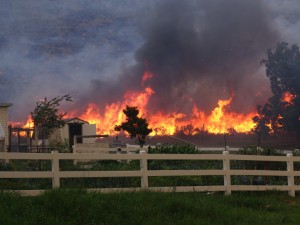Fireblocking and Firestops
Hansen Pole Buildings’ Designer Rachel was recently quoting a project for a governmental entity where the contractor requested her to include all provisions for fireblocking and firestops. This led to my deep dive into International Building and Residential Codes (IBC and IRC respectively).
Both have established a means to control fire spread within void spaces created within wood framed assemblies.
During a fire, flame and heated combustion products can spread via least resistance paths. Certain assemblies, particularly wood frame assemblies, result in concealed voids or cavities within walls, ceilings and attics. These not only affect fire spread, but also make suppression more difficult.
Fireblocking involves field-installed building material use to prevent undetected flame and gas movement to other areas through such concealed spaces. Although such materials are not required to be tested for fire resistance, they are to be installed to slow fire migration, and to contain a fire until it can be suppressed.
Fireblocks should not be confused with firestops. Firestops are code required when a higher fire protection degree is required, particularly when penetrations through fire resistance rated assemblies are to be protected with a specific material assembly tested under severe fire conditions for a prescribed time period. Unlike fireblocks, firestops purpose is to prevent fire spread from one compartment to another through service and utility openings in floors, ceilings, roofs, and walls.
Fireblocks are required between floors, between a top story and a roof or attic space, in furred spaces or cavities between studs in wall assemblies, at connections between horizontal and vertical spaces created in floor joists or trusses, soffits, drop or cove ceilings, combustible exterior wall finishes and architectural elements, and at openings for pipes, vents, ducts, chimneys, and fireplaces.
Fireblocks conform to innumerable configurations, depending on concealed space dimensions and location. IBC Section 718 (Concealed Spaces) is a dedicated section providing description of two concealed spaces and fireblocking. Section 718.2.1 identifies materials acceptable for use as fireblocks. Fireblocks can be constructed of materials such as two inch nominal lumber, structural wood panels, gypsum board, cement fiber board for larger fireblock, and mineral wool or glass fiber batts or blankets, loose fill insulation, and caulks, sealants, and putties for smaller fireblocks. IRC has similar text.
Frequently, and inevitably, pipes, vents, ducts, and similar items penetrate fireblocks. IBC requires fireblock integrity be maintained in 718.2.1. This may be accomplished by using a sealant, caulk or putty as permitted by 718.2.5. Such materials are required to be approved for such use, and may be either combustible and noncombustible per specific code section and application. Noncombustible sealant use would address both conditions where either combustible or noncombustible are required, but not vice versa. Therefore, a noncombustible material would serve a broader use range than a combustible sealant, caulk or putty. (Noncombustibility shall be determined by testing to ASTM E 136 per other code sections).
All chimneys and fireplaces are required to be fireblocked by code. Factory-built chimneys and fireplaces are required to be fireblocked by code, but are also required to be tested in accordance with UL 103 and 127. Those test methods contain specific information pertaining to fireblocking beyond code requirements.
In all building codes, designs and location for fireblocking are required to be indicated on construction documents, and are subject to inspection before occupancy in new construction.
 The International Wildland-Urban Interface Code (IWUIC) is a model code intended to be adopted and used to supplement the adopted building and fire codes of a Building Permit issuing jurisdiction. The IWUIC has as its primary objective the establishment of minimum specific regulations for the safeguarding of life and property from intrusion of fire from wildland fire exposures and fire exposures from adjacent structures and to prevent structure fires from spreading to wildland fuels, even in the absence of fire department intervention.
The International Wildland-Urban Interface Code (IWUIC) is a model code intended to be adopted and used to supplement the adopted building and fire codes of a Building Permit issuing jurisdiction. The IWUIC has as its primary objective the establishment of minimum specific regulations for the safeguarding of life and property from intrusion of fire from wildland fire exposures and fire exposures from adjacent structures and to prevent structure fires from spreading to wildland fuels, even in the absence of fire department intervention.





